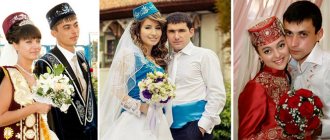Wedding traditions in Russia are a mixture of ancient Russian rituals, traditions of the Soviet period and Western trends. Recently, more and more often we can see Western-style weddings being held in Russia: with on-site registration, without toastmaster, competitions, accordion player, ransom and loaf, but still the majority still prefer classic Russian weddings. In this article we will take a closer look at how a traditional Russian wedding takes place.
Before the wedding
There are many signs and traditions, and some of them relate to the period of preparation for the wedding: this is traditional matchmaking, which now takes the form of a small feast for parents and newlyweds.
There is also a tradition of bachelorette and bachelor parties. According to Russian traditions, the bachelorette party was held before the wedding day: the bride's friends gathered there, the bride cried and wailed, said goodbye to her girlhood, and unbraided her hair.
Nowadays, hen and stag parties are increasingly held as we often see in Hollywood films - fun, noisy and with alcohol.
Let's return directly to the day of celebration. What ritual begins almost any Russian wedding?
Traditions at a wedding: Russian signs and customs for the start of a happy family life
It is believed that observing certain wedding signs gives warmth and happiness in family relationships . Age-old traditions are not subject to doubt or discussion, since they are passed on from parents to children. Often, it is the closest relatives who are responsible for the customs, without which the wedding event is incomplete. Undoubtedly, many newlyweds have to look for a compromise.
Photos of the wedding ceremony
Bride ransom
Previously, the phrase “bride price” was not a metaphor at all! Indeed, the bride was bought from her parents' house.
Now money has faded into the background. The bride price, which is usually organized by the bridesmaids, takes place in the house of the girl's parents and includes competitions. By going through these competitions, the groom proves that he knows and loves the bride well, and the groom's friends should come to his aid.
This is how the wedding fun begins. Having gone up to the bride's house, the groom takes her to register the marriage. Usually, during the bride price and after it, the bride's parents arrange a small buffet.
Wedding ceremony of handing over the family hearth to the newlyweds
The whole essence of this ritual is that it is the parents of the young who symbolically transfer the warmth from their family hearth to the new family. The ritual itself is carried out at the end of the wedding festivities, when the newlyweds themselves go to the new home and the parents, both from the groom and from the bride, light a candle and at the same time light the common candle of the newlyweds with two candles, while pronouncing wishes and instructions for the young family.
The ritual itself also provides for the direct participation of wedding guests. They form a circle and also hold candles in their hands, thereby forming a kind of protective circle around the young ones. The lights in the hall are turned off and the newlyweds stand in an improvised protective circle with one common wax candle. At this time, each of the guests says a short wish and then raises the candle up and mentally repeats the wish spoken out loud and lowers the candle.
Wedding ceremony
After the ransom, traditionally the couple, followed by the guests, go to the registry office, where the marriage is officially registered. The newlyweds perform their first dance there, for which they often order live music.
After accepting congratulations from the guests, a small photo session is usually held, first for everyone, and then only for the newlyweds, during which the guests prepare for the bride and groom to leave the registry office.
Guests sprinkle the newlyweds with rice (for the early birth of children), candies (for a sweet life), coins (for wealth) and rose petals (for a beautiful, romantic life together).
Orthodox couples who belong to the church also undergo a wedding ceremony in the church.
Wedding signs and rituals for a happy family life
I would like to once again dwell on certain signs and customs, the observance of which, according to the beliefs and convictions of many, can make the marriage itself strong and long. In particular, there are a lot of signs regarding the bride’s attire. First of all, we are talking about the number of buttons on the bride’s dress - it must be even, while the bride’s shoes must not contain laces or strings, and underwear must be white.
Many people believe that the number of guests at a wedding should be odd - this will ensure the newlyweds have a long and happy family life together. After the wedding in the temple, the bride had to give out change to everyone she met - this is what ensured the young family prosperity and financial well-being. But showering a couple with grain or candy also promised the couple prosperity and a sweet, prosperous life.
An equally interesting wedding sign is that many newlyweds put small coins in a glass for prosperity and success. It is these coins that should be kept in the future under the tablecloth on the table in the newlyweds’ house. This ritual was accompanied by attracting wealth and well-being to the home.
Wedding walk
After registering the marriage, the guests (often only young friends and girlfriends of the newlyweds) go for a walk around the city. At the same time, they try to visit the most beautiful sights in order to take pictures there.
Seven Bridges
We have all seen the groom carry the bride across the bridge. It turns out that this ritual also applies to wedding customs and traditions in Russia.
It is believed that if the newlyweds cross seven bridges on their wedding day, their marriage will be strong. It rarely happens that a couple manages to go around all seven bridges, but everyone tries to cross at least one.
Also, a padlock with the names of the newlyweds is often hung on the bridge, which, according to legend, seals the marriage.
Bread and salt
Traditionally, after the wedding, newlyweds come to the house of the groom's parents, where they meet them with bread and salt.
Usually the new mother-in-law holds a loaf of bread on a towel (a special towel), from which the bride and groom must take a bite. Whoever bites off the most will be the head of the family.
Wedding traditions and customs of the Russian people these days are losing touch with religion: previously, the groom’s parents used to bless the newlyweds in this way, and the groom’s father kept icons for this. Loaf for a wedding is a tradition that originated from here.
Now the wedding loaf is greeted at the restaurant where the banquet on the occasion of the celebration will be held.
Rituals and traditions at a wedding
Each ritual associated with a wedding has long-standing roots. Rituals and traditions have migrated from ancient times to the modern world in a slightly modified form.
But, nevertheless, they remained, and many today consider their observance to be the key to a happy family life. First of all, I would like to focus on such an ancient ritual as matchmaking. The modern matchmaking ceremony is quite simple - the ancient wedding rituals associated with this moment have been somewhat simplified.
Today, the matchmaking scheme itself is limited to the fact that the potential future husband, having received consent from his chosen one, visits the bride’s parents. In this case, a mandatory attribute is a bouquet presented to the future wife herself and her mother - her mother-in-law. For the most part, the bride's parents have known their potential son-in-law for months and are not at all against his candidacy as a husband for their daughter. In general, the matchmaking ritual is more formal in nature.
The same matchmaking ceremony takes place with the parents of the potential spouse of the future bride. The father-in-law and mother-in-law welcome the future father-in-law and mother-in-law, as well as a potential daughter-in-law, into their home. In general, after a joint feast, matchmaking is considered completed, and the engagement procedure itself is considered completed.
Festive feast
The celebration continues in a cafe or restaurant, where everything is ready for the arrival of the newlyweds. The decoration of the hall, tables and menu are usually chosen in advance.
This is a separate topic worthy of a huge post. Now we are talking about the traditions of the wedding feast.
Congratulations
The whole holiday is organized in such a way that special attention is paid to congratulations: everyone will have time to congratulate! Usually the parents are the first to congratulate, they are given the floor, and they seem to bless the children for marriage.
Afterwards, relatives congratulate: first on one side, then on the other, and then friends. Often, the bride prepares a special box in advance, in which she places envelopes with money so that they do not get lost.
Dancing
After the guests have eaten, the dancing begins. But here, too, traditions cannot be avoided. The first dance of the bride and groom is obligatory. Recently, it has become fashionable to prepare this dance in advance, to make it unusual, brides change their dress for the dance, grooms can also change clothes. Of course, such dances are remembered by guests.
Another dance, without which it is difficult to imagine a Russian wedding, is the dance of the bride and her father. With this dance, the father seems to be escorting his daughter to another family, saying goodbye to her. This touching dance reminds that a completely new time is coming in the bride’s life.
Family hearth
An ancient tradition that is still popular today. How to spend a family hearth?
- Organizers and assistants hand out small candles to guests.
- Guests stand in a circle and light candles.
- The lights in the hall turn off.
- To the accompaniment of slow music, the presenter tells a parable about a family hearth.
- Parents light their candles and approach the young people.
- A new candle flame is created for the newlyweds - a family hearth.
Ritual of removing the veil
According to tradition, at the end of the holiday, the mother-in-law or mother of the bride removes the veil. At first, the bride should not agree, only the third time does the mother manage to persuade her to remove the veil.
After the veil is removed, the groom undoes the bride's braids. During the ceremony, the leader usually explains what is happening and tells the story of the ceremony. This wedding moment always turns out to be very touching.
Wedding ritual of covering the bride
In this rather beautiful wedding ritual, a special place and participation is given directly to the bride and mother-in-law. It was our ancestors who endowed this ritual with special magical features. In the very ritual of covering the future wife and mother, the mother-in-law herself removed the veil from the young woman and covered her head with a scarf. It was precisely such actions that embodied the sacred meaning that a girl was already becoming a woman and a wife.
At this moment, the bride herself can, as if jokingly, throw off her scarf twice, but the third time the mother-in-law ties the scarf on her daughter-in-law’s head. After this, all the unmarried girls present at the wedding lead a young round dance around, while the bride herself tries on her veil on each head, thereby wishing each of them to get married as soon as possible and find their family happiness.
Second wedding day
But the holiday doesn't end there! The first day is followed by the second wedding day, the traditions of which include an informal celebration.
On the second day, guests most often gather outdoors, where they drink, sing songs and barbecue. These days, weddings are rarely celebrated for more than two days. After the wedding, the newlyweds can go on a honeymoon.
These are the wedding traditions in Russia. Of course, these are not all the rituals that exist; many of the traditions are already disappearing, but new ones are replacing them.
So, fortunately, at weddings we can find vulgar competitions, which were very popular 10 years ago, less and less often. Nowadays, themed weddings and outdoor weddings are gaining popularity.
In any case, you do not have to follow all wedding traditions and customs, the main thing is that your wedding is memorable and you like it!
Wedding traditions - meeting the newlyweds
Wedding traditions have been compiled for decades, and one of the important moments in the wedding ceremony is the ceremony of welcoming the newlyweds with a loaf of bread and blessing the couple by their parents. It is worth saying that wedding ceremonies, which included the process of parental blessing itself, were a prerequisite for a full-fledged Orthodox marriage and were held before the wedding in the church.
The meeting itself and receiving the parental blessing begins with the newlyweds passing through a kind of corridor created by the wedding guests from towels and standing in front of their parents. After bowing three times to their parents, the newlywed couple solemnly receives a blessing and a wedding loaf from them. Having received a loaf of bread from their parents, the newlyweds each break it from their side and, dipping it in salt, give each piece to their spouse to eat.
Wedding traditions give a special place to the wedding cake, since no wedding can be imagined without this decoration of the ceremony itself. It is the moment of joint cutting of the wedding cake - a huge confectionery structure of cream and sponge cake - that will remain in memory as one of the brightest and most colorful moments of the wedding.
The tradition of presenting a wedding cake to newlyweds has its roots in Ancient Rome. Despite the fact that 5 thousand years separate us from those times, this wedding ceremony has survived to this day. But it is worth saying that although people did not know or use the very concept of a cake at that time, in the ceremony itself at the wedding they used wedding bread baked in accordance with all traditions from barley or wheat.
According to the very ritual accepted in those days, the groom was obliged to break the wedding bread over the head of his chosen one and then give each guest a small piece of it, thus offering to share the joy with the groom. The crumbs themselves, which fell on the bride’s head from the broken wedding bread, were collected by the groom and shared with his chosen one. This ritual acted as a kind of symbol of the subordination of the future wife to her husband.
In Rus', such a wedding cake was a traditional loaf. It was in this regard that our ancestors approached on a grand scale and with good knowledge of the matter, since the preparation of this wedding attribute required the efforts of several people.
It was our ancestors who knew that kneading the wedding loaf was done exclusively by married women, and the process of baking in the oven itself was done by men. But the wedding loaf, decorated with viburnum branches and berries, was cut by the child himself. Then, at the wedding celebration itself, the cut loaf was served to the guests exclusively by the matchmakers themselves. Moreover, this entire procedure of treating guests to a wedding loaf was accompanied by the singing of ritual songs. They were performed by “loaf makers”. As a rule, the honor fell to the young people to be the first to touch the most finished loaf, and all this was done before the wedding in the temple.
Release doves into the sky
The roots of this wedding tradition go far back. The white dove is a symbol of purity and innocence. The bride released it into the sky as a sign that she was leaving her parents' home. On the one hand, the custom is quite sweet and beautiful, but on the other hand, it also has many disadvantages.
When flying, pigeons can ruin the guests' outfits - c'est la vie. True, the agencies assure that such a nuisance will not happen, because they stop feeding the birds a day before the ceremony. And this is another drawback, because not everyone likes the ethical component of the process. Particularly impressionable animal lovers may regard this as a mockery of our smaller brothers. In addition, you can accidentally hurt the bird or even damage something by squeezing it too tightly in your hands. Not everyone will be able to carefully and confidently hold a pigeon, because birds often behave restlessly, scratch with their claws and strive to fly away faster.
To summarize: this tradition is as old as time. It is not original and not as harmless as it might seem at first glance. It is better to abandon the pigeon torment in favor of something more modern and at the same time no less symbolic. You will find many examples of beautiful wedding ceremonies in our article.
|
Matchmaking
Wedding ceremonies in Rus' were distinguished by the fact that this action took place without the participation of the newlyweds. This event was usually planned for Sunday or some other holiday. The groom's parents took with them a trusted person - a matchmaker. It was she who had to represent the interests of the young man to the bride’s side. She praised the groom in every possible way and discussed the dowry with the bride's parents. At the end, the matchmaker took both parties by the hands and walked them around the table three times, after which they crossed themselves in front of the icons. When leaving, the groom's father set a date for the viewing. As a rule, they took place a week after the matchmaking.
A wedding without traditions - interesting and unusual wedding ideas
The most popular ceremony is the sand ceremony for a wedding: the bride and groom pour black and white sand from vessels into one container, thereby promising each other that from now on they will be one and can never be separated. The pattern that is obtained by mixing sand of different colors always turns out individual, just like people’s destinies.
Sand ceremony at a wedding
The next touching ceremony begins with the newlyweds writing two letters to each other . In them, young people guess the first 10 years of married life. The following provisions can be specified :
- what joint goals do they adhere to;
- what feelings they experience the night before the wedding;
- how they wait for this day;
- who will drink the most at the holiday;
- who will dance the most fiery dance;
- who will say the longest toast;
- who will give the largest bouquet;
- what they swear to each other.
In addition, messages can be supplemented with :
- include additional letters to future children;
- add pictures;
- express feelings in poetry.
The longer the letter, the more interesting it will be to read on your 10th wedding anniversary. Next, you need to purchase your favorite drink that will not spoil within such a period of time. It is placed in the box along with the letters. The joint of the lid is sealed with wax candles and, accordingly, with a seal.
If it happens that the newlyweds in a few years will not be able to cope with any life situation, this box can be opened ahead of schedule. By taking out your favorite drink and remembering your feelings, you can improve your relationship. This idea is called the box hammering ceremony and is even recommended by psychologists.
Hay or wood shavings, as well as ribbons, will make the box more elegant. You can close it with a lock or nails
It is better to have a beautiful wine ceremony at a wedding during registration. This will make the marriage more complete. A time capsule can become a family heirloom, reminiscent of this day, and a good piece of furniture.
How to make wedding rituals more relevant
When compiling a guest list, newlyweds often know which of them will come with a couple and which will come alone. Passing the wedding baton is a favorite story. To successfully conduct the competition, you can count single girlfriends and friends, and then play their numbers at auction.
In addition to the bride's attribute, such as a garter, guests are also given a piece of a tie, which acts as an anti-garter. The one who catches her, according to tradition, will not have time to get married within a year. This ritual will be especially in demand among single men with a good sense of humor.
You shouldn’t refuse a young person’s first dance even if you have no skills, because you can get help from a professional . A choreographer or director will add professional ones to amateur movements. A special atmosphere for the room is given by the team or bright props.
First wedding dance of the newlyweds
Another option is to perform the song as a duet. The first live wedding video is not prohibited from being performed with a soundtrack. Guests are unlikely to expect this, so it is joyful to be surprised in any case.











